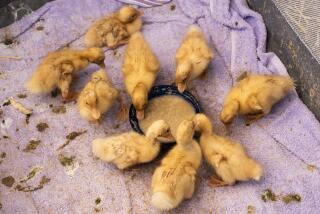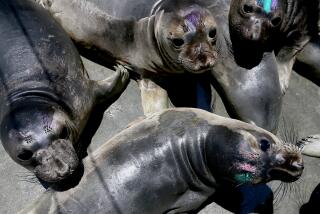It’s a Whale of a Revival Plan
BOURNE, Mass — BOURNE, Mass. -- The stranding of about 60 pilot whales on the Cape last summer was a wrenching experience for would-be rescuers. They watched the whales repeatedly beach themselves and eventually die, despite efforts to guide them back to sea.
But the toll of future beachings may be less severe if plans for a hospital for beached marine animals are finally realized in Buzzards Bay. Those plans have been boosted with agreement on a long-awaited lease that might also create some much-needed economic activity for the area.
The National Marine Life Center would have pools where animals ranging from whales to sea turtles could recover from strandings. There also would be exhibitions that organizers say could be expected to draw as many as 400,000 people annually, possibly reviving Buzzards Bay’s moribund waterfront.
“Main Street, Buzzards Bay, is in great need of an attraction, especially such a positive facility,” said Bill Griffin, town administrator in Bourne, which includes Buzzards Bay.
The center’s executive director, Sallie Riggs, has no trouble envisioning the completed project as she stands on the empty, weed-filled lot behind the site where the animal hospital will be.
“I see it,” she said. “I see it in my sleep. I see it in the daytime. I know what this is going to be.”
The $7-million project has struggled for traction since it was conceived by a group of grass-roots advocates in 1995. Bourne was suggested as the center’s home the next year, and an unused piece of property downtown was designated.
Fund-raising stalled in 1999, though, when Bourne voters changed their form of government just as the center was set to sign a new lease, Riggs said. The center receded on the town’s list of priorities and the perception grew that the project was foundering, she said.
But in late March, town officials agreed to a 50-year lease on the land at $1 a year, provided construction begins by Aug. 31, 2007.
The agreement allows officials to begin getting permits for rehabilitating the property -- a former Mobil Oil facility and lumber yard -- and assures investors that the center is not just a pipe dream, Riggs said.
“It certainly says to people, ‘Yes, this project is going forward,’ ” she said.
About $2.5 million has been raised and another $1.9 million is needed before the first phase of construction can begin, Riggs said. The center is banking on a federal economic development grant that it will pursue jointly with the town, as well as private donations.
Buzzards Bay was once the gateway to the Cape, enduring miserable summer traffic in exchange for a steady stream of tourists that kept Main Street businesses hopping. But the village has struggled in the decades since highway construction on Route 6 and Interstate 495 allowed travelers to bypass the village on their way to Cape vacation points. Today’s Main Street is a collection of scattered businesses, many with an abundance of empty parking spaces.
The marine rehabilitation center would help some of the old-time traffic return by capitalizing on the obvious emotional ties between people and sea mammals, Griffin said.
The project also would reopen access to the Cape Cod Canal. Brush and rusted barbed wire fence that sits behind the site would be cleared, and paths to the canal would be built through restored wetlands.
From a scientific perspective, the Cape is an ideal place for a marine animal hospital because it’s one of the “hot spots” for strandings on the East Coast, said Katie Touhey of the Cape Cod Stranding network, which would take animals to the new center.
Mass strandings get a lot of attention, but single strandings take place constantly and the quicker animals can get care, the better, she said. Last year, about 500 animals, including about 200 sea turtles, beached themselves.
The reasons that animals beach themselves on the Cape are largely unknown, although the peninsula’s hook shape is likely a factor, Touhey said.
“It’s sort of a little trap,” she said.
Mammals such as whales and dolphins travel in tightly knit packs and often follow sick members to shore or accidentally group in shallow waters, Touhey said.
Riggs said the turtles feed in the nearby Stellwagen Bank and sometimes drift to shore after being stunned by the cold waters of Cape Cod Bay.
The 20,000-square-foot center would have eight pools of various sizes to care for the animals, several more than Connecticut’s Mystic Aquarium, which is now the closest facility.
Pilot whales and dolphins would be treated in a large pool that is planned for what is now an empty warehouse storing little more than warped plywood and standing puddles of water. A smaller tank next to it would have a floor that could be raised and lowered so that scientists could more easily treat sick animals. A 12-foot animal is the largest the hospital could admit.
A variety of treatments would be available, Riggs said. Dolphins caught in fishing line would be freed and administered antibiotics after any wounds were cleaned. A seal pup separated too early from its mother would be fed a formula that mimics the fat in the mother’s milk. Sea turtles, which often develop pneumonia after being stunned by the cold water, would be warmed up, treated for the sickness and rehydrated.
Visitors could study exhibits on the animals and strandings, but they would be able to see ailing animals only through one-way glass so that they wouldn’t interfere with the care before the animals are returned to the wild, Riggs said.
The facility would also have equipment to perform necropsies. Ultimately, the hospital would allow researchers to understand what makes animals strand themselves, as well as the ocean environment they come from, Riggs said.
Not every animal that strands should be saved, Riggs said. Some beach themselves because they’re mortally sick. But healthy mammals caught following a sick friend, or animals ill from man-made pollution, deserve care that the hospital could provide.
“If humans are part of the reason,” she said, “we need to be part of the cure.”
More to Read
Sign up for Essential California
The most important California stories and recommendations in your inbox every morning.
You may occasionally receive promotional content from the Los Angeles Times.










